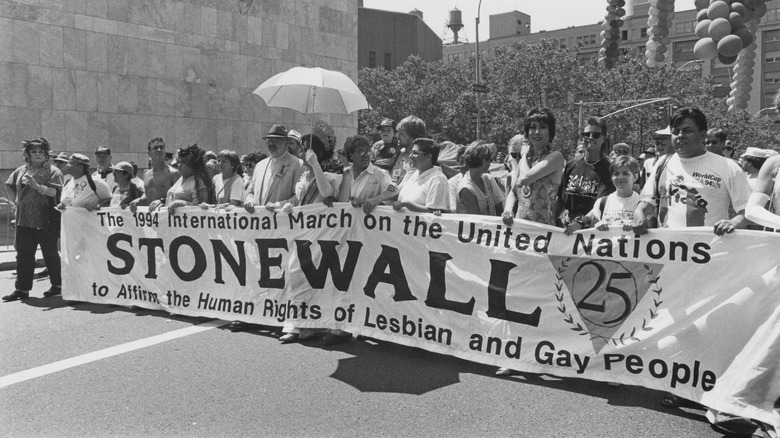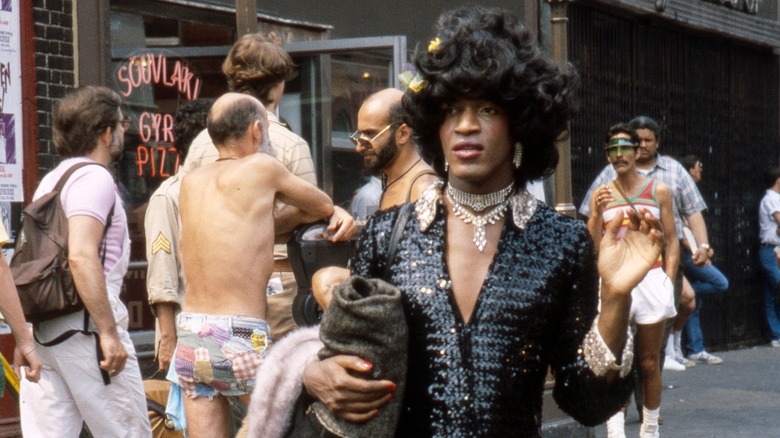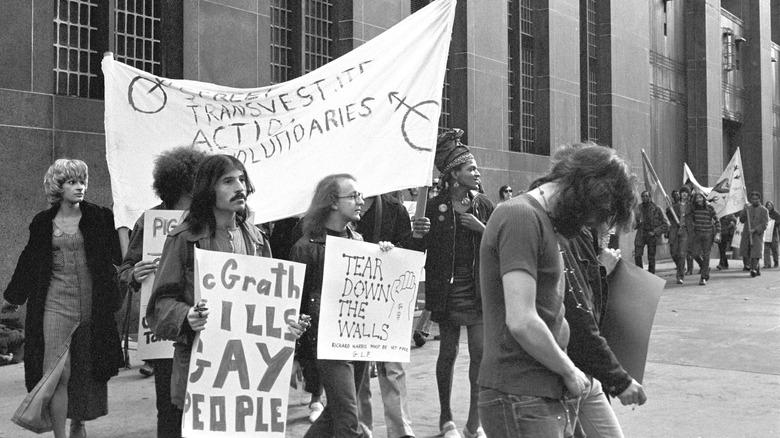The Women Of Stonewall: How Marsha P. Johnson And Others Rioted For Rights
It's a difficult time for the LGBTQ+ community in this country, and we all want to support our loved ones in the face of danger and struggle. As a result, it's comforting that Pride month has provided a much-needed sense of community, solace, and joy this year. Part of supporting the LGBTQ+ community beyond voting is simply putting forth an effort to educate ourselves. Learning the history behind Pride month, what this time represents, and the folks who paved the way is a great way to do that.
June 28th marks the anniversary of The Stonewall Riots. This year marks 54 years since the protests for LGBTQ+ rights. During the time of the riots, New York bars couldn't have licenses to serve gay people. The Stonewall Riots were a response to a police raid of a New York City gay bar, the Stonewall Inn, where thirteen people were arrested. Most of us have likely heard of Marsha P. Johnson, the Black transgender woman who was at the forefront of the riots back in 1969 and consequently initiated the modern LGBTQ+ rights movement. Of course, though, Johnson wasn't alone in sparking this event. To celebrate the anniversary of this historic day, we're highlighting some of the women who were vital to the protests' initiation.
Marsha P. Johnson
Marsha P. Johnsonwas a well-known gay liberation activist throughout her life, as well as a sex worker and a drag performer. She grew up in New Jersey where she was a victim of bullying and sexual assault. The "P" in her name stood for "pay it no mind," her motto. She was just 23 years old when she was on the front lines fighting against the police at the Stonewall Inn raid. There is some confusion over Johnson's exact role in the riots: Some say that she was the first one to throw a brick at the police, effectively beginning the riots, while she said that the riots had already begun when she arrived on the scene. Regardless of how she first got involved, she continued the protests that took place in the days that followed.
Johnson stayed committed to her activism for the rest of her life. A year after Stonewall, she co-founded STAR (Street Transvestite Action Revolutionaries) with fellow activist and friend, Sylvia Rivera. STAR was a homeless shelter for young transgender folks, which Johnson and Rivera funded themselves. It was the first LGBTQ+ youth shelter to exist in North America, as well as the first organization that was ever started by trans women of color in the United States.
Sylvia Rivera
Sylvia Rivera was just 17 years old when she acted as a leader of the Stonewall Riots, but she had already lived a life of activism. Rivera was a Latina trans woman whose grandmother raised her. Her grandmother physically abused her for behavior that she deemed gender-nonconforming. Consequently, Rivera was only 11 years old when she ran away from home. She headed to Times Square, where she became a sex worker and met Marsha P. Johnson and a group of drag queens who welcomed her.
According to Rivera, she was the second person to throw a Molotov cocktail at the police on the night of Stonewall. In the wake of the protests, Rivera then co-founded the Gay Liberation Front, which fought for gay and women's rights among other causes. A year later, she co-founded STAR with Marsha P. Johnson. She spent her life advocating for more marginalized groups to be highlighted in the LGBTQ+ rights movement, rather than its focus on white middle-class members of the community. She famously spoke about this in a speech at a pride rally that became well-known as her "Y'all Better Quiet Down" speech, per YouTube.
Miss Major Griffin-Gracy
Miss Major Griffin-Gracy is a Black trans woman who fought for LGBTQ+ rights all her life. She grew up in Chicago, where she struggled with her gender identity –– often trying on her mother's clothes at home but not revealing her female identity to the outside world. Griffin-Gracy was a regular at the Stonewall Inn, and she took part in the riots. The first night, a police officer involved in the raid broke her jaw, leaving her unconscious. She was then taken into custody, where she stayed for the next five years.
Upon her release, she continued to advocate for women of color who had suffered from police brutality and were incarcerated. She ultimately became the Executive Director of Transgender, Gender Variant and Intersex Justice Project (TGIJP.) She later founded the House of GG (the Griffin-Gracy Educational Retreat & Historical Center,) a retreat space for trans folks. The award-winning 2015 documentary, MAJOR! follows her life and activism and goes into great detail about all that she accomplished.
Stormé DeLarverie
While it will never be known for sure, many believe that Stormé DeLarverie was the first person to actively start fighting at the Stonewall Riots. In an interview with the New York Times, her friend shared, "Nobody knows who threw the first punch, but it's rumored that she did, and she said she did." She was at the Stonewall Inn when the rioting started, and a police officer pushed her, at which point she punched him in the face. She was then attacked and handcuffed by multiple officers, one of whom hit her over the head with a baton.
DeLarverie was biracial and grew up in the South, where her Black mother was her white father's servant. She moved to Chicago to escape the South at age 18, where she shared her identity as a lesbian with the outside world. There, she co-founded the Jewel Box Revue, which was the first touring drag company in North America that included folks of different races. She was the only drag king in the shows. Her activism continued after Stonewall, and she was known as the Rosa Parks of the LGBTQ+ community for her work and her important role in the Stonewall Riots.


